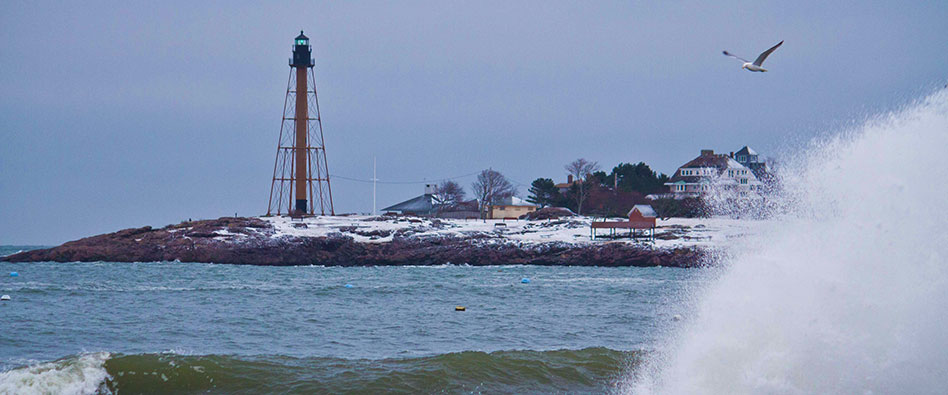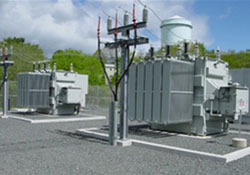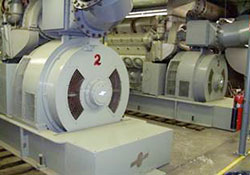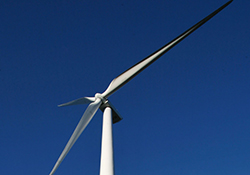
MMLD's History in Brief

MMLD's History in Brief
Marblehead is a leading community in the Commonwealth. So is its light department. Click the tabs below to read about our century+ years of service. Or, view our Video History—just click here.

On March 15, 1894 Marblehead Town Meeting voters made the decision to establish our town's own electric utility by an overwhelming majority of 319-20. This historic vote included a commitment to build a new plant at a cost of $62,687.50.
The Light Plant was completed on Commercial Street overlooking the harbor in 1895. The brick building contained two 150-horsepower steam engines in the engine room, two boilers in a separate room, a storeroom and an office. A 110-foot chimney stack with a four-foot flue topped off the facility.
The new plant supplied power after dark to 36 buildings using 537 commercial lights. On nights when there is no moonlight, the streets are lit by 165 arc lights and 40 incandescent lamps. The Electric Light Committee proudly noted at the time: "Marblehead is no longer behind other communities in regard to light." The plant and its customer base grow and grow until in 1907, 24-hour service was instituted (with the exception of Sundays and holidays...except during the summer).

In January of 1913, the "moon schedule" for street lights is abandoned after nearly 20 years of lighting the street only when there was no moonlight. Then in 1917, World War I brings tough times to the Marblehead. Our plant pipes steam for heating to the neighboring Burgess airplane factory at Redstone Cove, which builds biplanes for the war effort.
After the war, MMLD had to cope with an ever-growing demand for electricity due to Marblehead's popularity as a summer resort. Commissioners decided it would be cheaper to buy power from outside the town. In 1923, equipment is installed to handle current from Lynn Gas and Electric in Swampscott. By 1928, a new 15,000-volt line connects Marblehead with Swampscott.
By the mid-30s, despite the Great Depression, peak demand for electricity hits 1,400-kilowatts. We continued to purchase power from outside sources, although most power used here is generated in Town. Thanks to efficiencies and equipment upgrades, the residential lighting rate drops to 5 cents per kilowatt-hour, down from 13 cents in 1920.
The big one... The Hurricane of 1938 tore down poles and wire all over Town, but they were "rapidly put back in working condition". Major plant renovations include a new 750-kilowatt diesel generator and upgrades to the steam generation equipment. The "Town unemployed" perform labor such as excavation and foundation work for the project.
Good news in 1939. Rates are falling and the cost of electricity after 200 kilowatt-hours is lowered to 2 cents per kilowatt-hour to encourage the use of electric ranges and other new appliances. The idea is to build up daytime electric use to balance the heavy evening summer load caused by the large seasonal colony on Marblehead Neck.

World War II. Due to our coastal location, the plant was enclosed with a chain link fence topped by barbed wire, and was locked and guarded every night. Black-out restrictions required all street lights on the Neck and along the waterfront to be turned off. Other lamps are made smaller or are shaded or painted. Street lighting went back to the "moon schedule" of lighting only during dark nights.
By the end of World War II, growth of the Town's permanent population shifts the peak electric demand to wintertime. The Department's generation equipment was then used primarily during winter peak periods, with most energy requirements purchased until a new generator was installed, and another rebuilt, to handle post-war demand.
The town's first substation, Clifton substation, was completed in 1954 while the Department continued upgrading the entire distribution system to higher 41,600-volt lines. The original wooden horse stable is torn down in 1955 and is replaced by a concrete block garage big enough for 10 cars and trucks.
In 1957, Beacon substation was completed and a 23,000-volt line was built from Swampscott to Village Street.
We move in 1969 from our offices in the Rechabite Building on Pleasant Street into much-needed larger quarters above the plant on Commercial Street. Village substation, the Town's third, is energized in 1975. A new generation station is approved at the 1973 Town Meeting, and goes on-line in 1975. The new Wilkins station has two 2,750 -kilowatt generators used during peak use periods to hold down costs and assure reliability.

1977 and the fuel crisis introduced the word "conservation" into everyone's vocabulary. Our "Stop Peaking" program was introduced that year to encourage voluntary reductions in electric use during peak periods. Highly successful, the program became the model for other utilities throughout the Northeast.
Several years later in 1980, wise energy use remained a crucial part of cost containment, so we began to offer energy audit services to all of our customers.
A computer-controlled load management system, the first in the Northeast, was introduced in 1988 to directly control water heaters and central air conditioners during peak use periods. SAVERLIGHTS, energy-saving compact fluorescent bulbs, were supplied to customers through a lease program. Existing street lights were changed to more energy-efficient models and our 1947 generator was refurbished for continued service and optimum efficiency.
The people of Marblehead wholeheartedly support the Department's efforts to contain costs. By 1993, some 800 load management switches were installed, and more than 3,000 SAVERLIGHTS were in use. Looking toward the future, the Department built an electric-powered truck to demonstrate the clean, quiet potential of electric transportation. The Commission also established an off-peak charging rate for all electric vehicles in the fall of 1993.

1994 was our 100th Birthday celebrating a century of service to the people of Marblehead.
The Blizzard of 1996. On Monday evening, January 8, with most people at home during the "Blizzard of 96" the Town set a new all-time peak demand for electricity of 21,300 kilowatts. It topped the previous record of 21,175 set in 1989.
Later that year, Town Meeting voters overwhelmingly adopted a bylaw requiring removal of existing poles and overhead wires in the downtown area.
1996-1997 marked the beginning of a $3 million dollar project to upgrade the entire transmission system that brings power to Marblehead. The Lead Mill area at the border of Marblehead and Salem received a dramatic face-lift as two new bridges are constructed to carry three electric conduits from Salem, and landscaping improvements are made. In addition to enhancing system reliability the work has also left the area safe and attractive for hikers and bikers.
1998 As a result of legislation passed last fall, many electric consumers in Massachusetts will be able to choose their power supplier in a competitive market beginning March 1. As a non-profit utility, locally owned and controlled, the Marblehead Municipal Light Department is exempted from the March 1 start date. However, the law requires that municipal utilities that have not offered customer choice by March 1, 2003 conduct studies on it's pros and cons.
After eight years of planning and construction, the project to upgrade the Town's electric transmission system was completed this summer. The project, which involved replacing some 12,000 feet of older transmission lines between Marblehead and Salem, will result in a more reliable and efficient system capable of serving the Town's needs for the foreseeable future.
1999 After nearly three years of preliminary work and planning, construction began this spring on the second phase of a project that will place all utility services underground in the heart of Downtown. Work this year continued a focus on building the underground duct and manhole system that had to be completed before utility equipment could be installed. Through MMLD's Efficient Lighting Rebate program, the Light Department contributed $10,303 towards the cost of upgrading 2,168 existing lamps and/or fixtures at the Marblehead High School and Middle School. Estimated annual cost savings for the two schools total $18,353.
2000 After much preparation in anticipation of computer related problems at the dawning of the new millennium, the date passed without incident in Marblehead, and most of the world. MMLD establishes a direct debit plan, allowing customers to have payments for their electric bills conveniently deducted from their checking or savings account each month.
2001 After two years of planning and construction, a new electrical substation off Village Street was energized in July, adding at least a third more capacity to the Town's electric system.
Marblehead Light welcomed two new Light Commissioners this spring - Alan Chipman and Wilbur E. Bassett. Chipman, who is Commission Chairman, holds the seat previously occupied by Michael Hercher, while Bassett fills the position vacated by Carl Rohde. The new Commissioners join Charles O. Phillips, Jr., who has served the board since 1996.
MMLD institutes an Energy Efficiency Rebate Program to encourage customers to make energy efficient purchases of refrigerators, clothes washers, dishwashers, room and central air conditioners and dehumidifiers. In addition, rebates are available to those wishing to add insulation to their homes or purchase a programmable setback clock thermostat.
2002 The first residences and businesses are connected to the new Downtown underground utility system. As each customer is connected to the underground system, the wires from the pole to the building were removed, gradually eliminating the overhead system.
2003 At Town Meeting this year voters establish the expansion of the Board of Light Commissioners from three to five members. MMLD completes its share of the Downtown underground utilities project this summer, all customers in the designated area now receive their electricity from an underground service. The next large construction project, a "new" Clifton Substation (replacing the original substation completed in 1954) is begun.
2004 In May voters elect two new members to the Light Department Board of Commissioners. Welcomed to the Board are Calvin Crawford and Philip Sweeney, for a three and two year term, respectively. In the same election Alan Chipman is returned to his seat on the Board for a three year term.
The new Clifton Substation is completed, improving reliability and providing for future load growth. Poles and overhead wires are removed downtown, completing the project of burying utilities underground and beautifying the Old Town area.

2005 The start of a multi-year project began on the causeway. The adding of duct and manhole renewal process allowed for the removal of the overhead circuits.
Support for renewable resources, such as our participation in the Berkshire Wind Project, as well as interest in a Biomass Project, were a part of our overall efforts to reduce the power supply costs in 2005. These projects are protected from the volatile price swings of fossil fuels, providing us with a more balanced energy portfolio.
2006 This is the year for the completion of the upgrade on the 13KV supply line from Creesy Street to the Commercial Street, as well as the testing and energizing of the underground beneath the causeway. Replacement of the existing Beacon Substation originally installed in 1957 was nearing its end of useful life. In October crews began installing new underground within the renewed duct work. By the end of December the substation was completed and operational.
In 2006, the department also assisted in funding two residential photovoltaic installations in town. MMLD was selected to participate in the Locational Forward Reserve Market (LFRM) after winning the bid process. This allowed the Light Department to maximize the value of it own diesel generation facilities at the Wilkins Station. The market established a price for generators located within Northeast Massachusetts load zone that could be fast-start (30 minutes or less) in order to supply capacity deficiency. This internal asset saved our customers in excess of $400,000 that year.
2007 Our membership in the Massachusetts Municipal Wholesale Electric Company (MMWEC,) together with 14 other municipal light departments, participated in an initiative to purchase the assets of Berkshire Wind Power, LLC. Berkshire Wind Power assets would add a source of clean renewable energy to our overall energy portfolio. The projected date to be on line was 2010.
2007 brought the installation of a new distribution feeder from the Clifton Substation. This new circuit provided additional capacity due to the new YMCA.
2007 also continued our evaluation of the BPL (Broadband Over Power Lines) program. This allows electric utilities access to smart-grid technologies resulting in lower power costs, less pollution, greater reliability and security.

2009 Work crews completed a multiyear project in early 2009 called the "1303 Project". This project replaced approximately 30 poles from Lincoln Avenue to West Shore Drive, and included the replacement of an old 13 kV aerial spacer cable providing firm supply to the newly refurbished Beacon substation.
While work crews were busy completing the "1303 Project", another multiyear project to replace existing Commercial Street Substation was well under way. This multi-million dollar project would completely replace the existing substation equipment including transformers, switchgear, and underground cables. The Commercial Street facility, which was originally constructed in 1895, has seen several upgrades over its history, but this was the first significant upgrade to the substation equipment since 1960. When completed, this upgrade plan would significantly increase reliability to our customers, reduce noise, while incorporating an aesthetic design not typically found in traditional substation projects. The substation was scheduled to be online by early 2010.
In August of 2009, MMLD submitted a comprehensive application to the Department of Energy (DOE) for participation in the Smart Grid Investment Grant (SGIG) program. The topic area for the MMLD application was for a town-wide integrated advanced metering infrastructure system, also known as smart metering, with a total project cost of $2.7 million. The federal government grant is worth 50% of the proposal’s total or $1.35 million. MMLD was one of the only one hundred companies nationwide selected for negotiations for an award with the DOE. According to the DOE, the awards amount to the largest single energy grid modernization investment in the country’s history. The department worked with DOE representatives to finalize the plan including the scope, milestones, timetables and reporting requirements.
2010 After ten-plus years of careful planning and development, the vision of the Berkshire Wind Power Project as a leader in clean, green, and renewable energy came to fruition. By the end of November 2010, all 10 wind turbines had been erected and work continued on the remaining critical path items. The 10-turbine, 15 megawatt project, was scheduled to begin operation in 2011 and produce more than 52,500 megawatt hours per year - enough to power approximately 6,000 homes. Marblehead’s share of the project was 6.7 percent or just over 1 megawatt.
The project achieved a renewable energy addition to our overall power supply portfolio, reduced dependence on fossil fuels and curbed greenhouse gas emissions. Over the life of the turbines, the operation of the Berkshire Wind Power Project will offset over 612,000 metric tons of carbon dioxide (CO2) production and the use of 1.7 million barrels of oil.
Throughout 2010, MMLD worked closely with the Dept. of Energy to coordinate the implementation of our new smart meter program. The 50 percent matching grant totaling $1,346,175.00 was finalized and awarded to MMLD on March 12, 2010. The MMLD project involved the town-wide installation of a fully integrated advanced metering system and a pilot program to assess the effectiveness of dynamic pricing and automated load management. It was aimed at reducing peak electricity demand, overall energy use, and operations and maintenance costs while increasing distribution system efficiency, reliability and power quality.
MMLD was one of only one hundred companies nation-wide, including only 33 public power systems, selected for negotiations for an award with the DOE. According to the DOE, the awards amounted to the largest single energy grid modernization investment in the country’s history. Full roll-out of the project is scheduled for early 2011.
2011 The vision of the Berkshire Wind Power Project as a leader in clean, green, and renewable energy finally came to fruition. The 10- turbine, 15-megawatt wind farm atop Brodie Mountain started commercial operation on May 28, 2011.
MMLD launched an exciting new online payment and e-bill service that offered customers more flexibility in paying their electric bills. The system is easy to use and allows customers the option to pay their bill utilizing a checking account or with a debit or credit card online or via text message. Billing information is available online 24 hours a day/7 days a week and is accessible through our website at here. There is also an option to go paperless.
Work crews completed several distribution projects in 2011. The Anderson circuit, which primarily serves the business and residential customers along Pleasant Street from Washington Street to School Street, had several poles and aerial spacer cable configuration without cross arms. This project improved reliability, as well as enhanced aesthetics to the area served.
The Schooner Ridge Road project replaced existing direct buried underground cable that was installed more than 30 years ago with new cable and conduit. The Neck circuit re-conductor project, a multi-year project, will replace existing cable with a new aerial spacer cable configuration along Atlantic Avenue and Ocean Avenue.
2012 MMLD conducted the second year, summer test of a pilot program we termed “Energy Sense” focused on reducing electricity usage during critical peak periods. MMLD worked with 500 households to voluntarily participate in the summer test. The Energy Sense pilot program is among the first of its kind in the region that reflects the actual cost of electricity delivery on critical peak days and offers customers price incentives to reduce household energy usage during specific peak periods. The goal of this program are to provide our customers with pricing options and real time usage information that enables them to control their electric usage and realize energy cost savings.
Projects for 2012: Neck circuit was in need of conductor upgrade to help support the voltage at the far ends of the circuit. Along Seaside Park and down Ocean Avenue to the beach, we replaced old wire with larger conductors to help reduce voltage drop. This included many pole replacements and equipment changeover to the new poles. After completion of that work, we began the replacement of the Beacon circuit’s main line along Beacon Street from Woodfin Terrace down to Norman Street. All new poles have been set and hardware has been rigged for the new larger wire, which is expected to be delivered early in 2013.
2013 The Beacon circuit was upgraded - consisting of replacing all poles from Woodfin Terrace to Norman Street, rigging all new hardware, hanging new conductors and changing over every house to the new wire, a complicated and time consuming process. Preparation for work on Clifton Avenue began by setting all new poles, rigging new hardware in expectation of completing that project in 2014.
In addition to our outside plant construction projects, we also began the review and design process for the Commercial Street Plant in 2013. Reviewing several previous studies and looking towards the future, we are nearly complete with a conceptual design of the facility. Not having been updated since the '70s, the facility is in need of considerable work to bring it up to today’s building code requirements. Originally constructed in 1894, it has served MMLD well and we plan to continue that service well into the future with thoughtful design and respect for the past.
2014 The installation of our Advanced Metering Infrastructure project (Smart Meters) at MMLD was completed in early 2014. Replacing all 10,400 meters had been a challenge for such a small workforce, but the effort is proving itself to be a good investment. During outages to our customers we are notified through the Smart Meter system as to the location of the outage. This notification in turn allows for faster restoration by identifying the location of the failed electrical component. These types of smart systems are the future of the utility business.
MMLD also created a Facebook page for the purpose of communicating important information and updates with our customers. This method of social media has received much positive response and is a wonderful avenue of 2-way communication on-the-go.